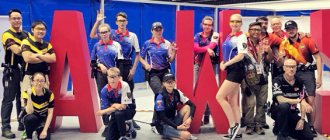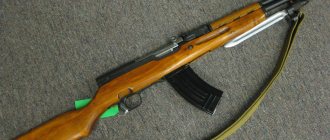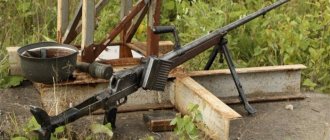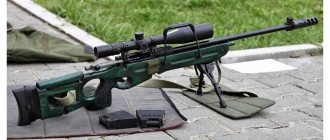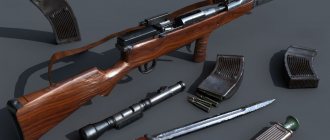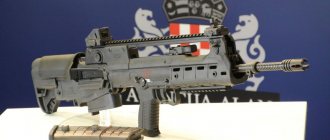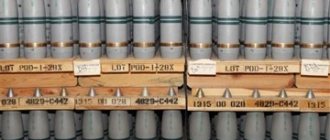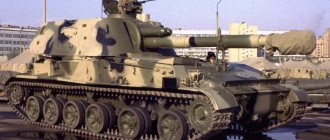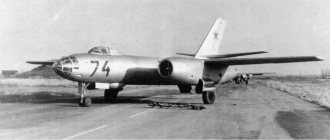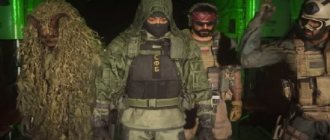| Czechoslovak People's Army | |
| Historical reenactor in a field soldier's uniform of the Czechoslovak People's Army | |
| Years of existence | 1954—March 14, 1990 |
| A country | Czechoslovakia |
| Subordination | Supreme Commander-in-Chief (President) |
| Included in | Armed Forces of the Department of Internal Affairs (1955 - 1990) |
| Type | Armed forces |
| Includes | ground forces, air force, air defense forces |
| Number | 350,000 (as of 1985) |
| Dislocation | Prague (General Headquarters) |
| Motto | For the Motherland - For Socialism (Czech: Za vlasť–za socializmus) |
| Marks of Excellence | |
| Successor | Czech Armed Forces, Slovak Armed Forces |
The Czechoslovak People's Army
(Czech: Československá lidová armáda, abbreviated as
ČSLA
) was the name of the armed forces of Czechoslovakia from 1954 to March 14, 1990.
Content
- 1 Previous events (1939-1945)
- 2 History 2.1 1940s
- 2.2 1950s
- 2.3 1960s
- 2.4 1970s
- 2.5 1980s
- 2.6 1990s
- 3.1 Ground forces
- 4.1 Ground forces
- 5.1 Generals and officers
Previous events (1939-1945)[ | ]
After the occupation of Czechoslovakia by Nazi Germany in March 1939, the country's army was disbanded. On September 27, 1941, an agreement on military cooperation was signed between the USSR and the government of Czechoslovakia, which emigrated from the country, according to which the formation of Czechoslovak military units began on the territory of the USSR.
- In January 1942, the 1st Czechoslovak separate infantry battalion was created. After completing the recruitment and training of personnel, on March 1, 1943, the battalion was sent to the front. Thus, the Czechoslovak battalion became the first foreign military formation to enter battle on the side of the USSR on the Eastern Front[1].
- In May 1943, the 1st Separate Czechoslovak Infantry Brigade was created[1].
- In April 1944, Czechoslovak units were united into the 1st Czechoslovak Army Corps[1].
As the front line approached the occupied territory of Czechoslovakia in August 1944, the Slovak National Uprising began, during which many military personnel and units of the Slovak army went over to the side of the rebels[1]. At the end of March 1945, the USSR donated weapons for ten infantry divisions, transport and communications equipment to the Czechoslovak army [1]. On April 5, 1945, the Popular Front program for the restoration of the Republic of Czechoslovakia was published in Kosice[2]. On May 4, 1945, American troops entered the territory of Czechoslovakia[3].
The conscription of conscripts and the formation of units of the Czechoslovak army began in May 1945[2]. On May 15, 1945, all Czechoslovak units were united into the 1st Czechoslovak Army[4]. During this period, the weapons of the Czechoslovak army (previously in service with the Slovak army and the German occupation forces) were retained for the arsenal of the Czechoslovak army, captured German weapons, as well as Soviet-made weapons and equipment were received.
From the moment of its formation until the end of the war, in combat operations against Nazi Germany and satellite countries of the Third Reich, units of the 1st Czechoslovak Corps disabled 30,225 enemy troops, destroyed 156 tanks, 38 aircraft, 221 guns, 274 vehicles and a certain amount of other equipment, seized a significant amount of weapons, equipment and military property[5]. The losses of the 1st Czechoslovak Corps amounted to over 11 thousand military personnel killed [6], 10 Czechoslovak military units and formations were awarded Soviet military orders, 40 thousand citizens of Czechoslovakia were awarded the medal “For the Liberation of Prague” [1].
In November 1945, American and Soviet troops were withdrawn from Czechoslovakia[3].
Missile Arsenal
In 1961 and 1962, Czechoslovakia signed the first contracts for the purchase of launch vehicles for nuclear warheads. Three missile (officially, heavy artillery) brigades were deployed across the country.
In those same years, the authorities of the two countries agreed, in the event of “extraordinary events,” with the help of “special component units,” to deliver nuclear warheads stored on the territory of the USSR. It was assumed that under optimal conditions, delivery and assembly of launch vehicles should have taken 18-22 hours.
The Soviet Union sold its satellite installations with R-11M missiles - or SS-1 Scud-A in NATO classification. These missiles could carry warheads with a yield of 10 to 40 kilotons, and the maximum range with a nuclear charge was 150 kilometers. In addition, the Luna installation was supplied to Czechoslovakia - the tactical missiles of this complex could carry a nuclear charge and had a maximum flight range of 32 kilometers.
Launcher of the Luna-M tactical missile system on the march during the Sever military exercises, Leningrad region, June 1976
On topic: How the Soviet Donbass reacted to the Prague Spring and its suppression. From the KGB archives
Later, these units were repeatedly modernized, and the number of launchers increased. In the late 60s and early 70s, new R-17 missiles, or SS-1c Scud B in the NATO classification, came to Czechoslovak units. The power of the nuclear warhead of these missiles increased significantly: depending on the modification, it ranged from 10 to 500 kilotons. The maximum range has also increased - up to 300 kilometers. If the old missile was not particularly accurate (50% of hits fell within a radius of 3 kilometers from the target), then for the new one the CEP indicator was 450 meters.
Launchers of the 9K72 Elbrus missile system during an exercise, date and location unknown
In 1985, the last rearmament of Czechoslovakian missile brigades began. The first Oka systems (NATO classification SS-23 Spider) arrived in the country. The range has increased again - up to 500 kilometers. The missile was equipped with a thermonuclear warhead with a capacity of 200 kilotons.
But all these missiles were equipped with training warheads or charges with conventional explosives. Czechoslovakia officially did not have its own nuclear arsenal. This meant that in the event of a conflict, the country’s troops would be left without the main firepower and could only rely on strikes from strategic nuclear forces.
The rocket of the Luna-M complex, ready for launch. Soviet Union, January 1970
History[ | ]
1940s[ | ]
After the end of World War II, in 1945-1947, units of the border troops, the Czechoslovak army and employees of the Ministry of Internal Affairs took part in military operations against the armed formations of Ukrainian nationalists who were trying to break into the zone of occupation of the Western allies from the territory of the USSR and Poland. The first cases of nationalist penetration took place in August - October 1945 in the area of the Dukla Pass; in November - December 1945, the OUN-UPA attempted to break into Slovakia with large forces. In the Ulich Valley they occupied the villages of Zboy, Novaya Sedlitsa, Ublya, Ulich (4 residents were killed), Kolbasovo (11 residents were killed). On December 14, 1945, the government of Czechoslovakia gave the order to strengthen the border garrisons and involve the army in the fight against UPA militants[7], and on the same day, a mobile border group “Janoshik” was created at the Dukla Pass under the command of Lieutenant Colonel Jan Stanek[8].
On December 19, 1945, while crossing the German-Czechoslovak border, Czech border guards captured the chief of the Main Military Staff of the UPA, Dmitry Gritsai (“Perebiynos”), and the deputy head and political assistant of the OUN Wire Bureau, Dmitry Mayevsky (“Taras”), who accompanied him, shot himself during the arrest[9]. A “border territory support group” was created in the border zone, whose military personnel drove the militants into Polish territory[7].
In April 1946, the UPA again invaded the territory of Czechoslovakia, occupying 33 settlements; 7 thousand military personnel (14 infantry battalions, 1 artillery battalion and 1 air squadron) took part in the fighting against the militants [7]. On April 18, 1946, UPA militants retreated to Poland. Total losses to the Czechoslovakian economy from OUN-UPA raids in 1945-1946. amounted to 55 million crowns[8]. In February 1947, the USSR, Czechoslovakia and Poland entered into a tripartite agreement on coordinating actions in the fight against OUN-UPA formations.
In 1947, there were further attempts by the UPA to break through into Austria through the territory of Czechoslovakia, to counter which a separate border regiment “Slovakia” was created. During this period, detachments commanded by “Bir”, “Hren” and “Stach” were defeated on the territory of Czechoslovakia, but several more detachments managed to break into the territory of Austria. In general, during the fighting against the OUN-UPA in 1945-1947, the losses of the Czechoslovak army, border guards and security forces amounted to 39 people killed, 81 wounded and 5 missing [7]. In 1947, military reform was carried out. On October 1, 1949, the government of Czechoslovakia adopted the Law “On the Defense of the Country,” establishing the basic principles of the organization of the armed forces and the tasks assigned to them[1].
1950s[ | ]
In 1954, the armed forces of the Czechoslovak Socialist Republic received the name Czechoslovak People's Army
(Czech: ČSLA / Československá lidová armáda). In May 1955, Czechoslovakia joined the Warsaw Pact Organization. After the creation of a collective security system for socialist states, on August 24, 1955, the government of the country adopted a resolution to reduce the army by 34 thousand people[3]. On July 24, 1956, the government of Czechoslovakia adopted a resolution on a secondary reduction of the army[3]. On December 18, 1959, Law No. 76/1959 was adopted, according to which changes were made to the system of military ranks[10]
1960s[ | ]
In 1960, a law on universal conscription was adopted, according to which male citizens aged 18 to 60 years were liable for military service, the conscription age was 19 years, and the conscription period was 2 years[2]. After the start of Operation Danube in August 1968, Czechoslovakia's Minister of National Defense Martin Dzur issued an order to prevent resistance to the entry of Warsaw Pact troops.
1970s[ | ]
Mi-8T of the Czechoslovak Air Force
On July 23, 1973, the Law “On Military Training” was adopted[1]. On January 1, 1979, a new law “On the Defense of the Country” was adopted[1].
1980s[ | ]
In 1987, the Czechoslovak People's Army had 201,000 people on active service. During the Velvet Revolution, Czechoslovakia's Minister of National Defense, Army General Milan Vaclavik, proposed using the army to suppress protests, but his proposal was rejected[11]. The Chief of the General Staff, Miroslav Vacek, who soon replaced Vaclavik in the ministerial post, was categorically against it. Under the command of Vacek, army units, together with police forces, disarmed the “People's Militia” - the paramilitary forces of the Communist Party of Czechoslovakia [12].
1990s[ | ]
On March 14, 1990, a decision was made to rename the Czechoslovak People's Army into the Czechoslovak Army (Czech: Československá armáda).
Pistol CZ-75 (Czechoslovakia)
Page 1 of 2
One of the stars in the generation of personal combat weapons that was born in the 70s of the 20th century, undoubtedly, was the Czech CZ-75 chambered for 9x19 “Parabellum” (“Luger”). By presenting it to the world in 1975, the Czechoslovak company Ceska Zbrojovka (founded in the town of Uhersky Brod in 1936 to produce military small arms) confirmed its high reputation. Very soon the pistol was recognized as one of the best examples of personal weapons created in Europe after the Second World War, and rightly continues to be considered so to this day. The CZ-75 became one of the finest pistol systems produced in Europe after 1945, widely sold around the world and even more widely copied.
CZ-75 pistol , experienced designers brothers Josef and Frantisek Koucki, did not improve the company’s models that were in production. They created a new design by creatively combining the best features of a number of serial pistols of various brands, primarily the famous Browning High Power.
The automatic operation of the CZ-75 pistol operates according to the recoil pattern of the barrel with a short stroke. The barrel is engaged with the bolt casing by two upper lugs in front of the chamber, and the lowering and raising of the breech during recoil and retraction occurs due to the interaction of a figured cutout in the lug under the chamber with the bolt stopping axis. The return spring is placed in a niche of the frame under the barrel and is equipped with a guide rod. The main novelty was the movement of the shutter casing not along the external, but along the long internal guides of the frame. This solution was patented by S. Setter in France back in 1935, then, in the late 1940s, it was developed and successfully tested in the Swiss STG P210.
In addition, the CZ-75 received a trigger mechanism (trigger mechanism) with a self-cocking mode - apparently, the developers were impressed by the American Smith & Wesson Model 39. Accordingly, the position of the trigger and the safety box on the frame changed. The trigger is semi-hidden, with a spoke. The force from the screw mainspring is transmitted to the trigger through a curved rod. The inertial firing pin is held in the bolt by the rear plate. The trigger rod surrounding the magazine engages with an L-shaped disconnector secured to the trigger with a pin. In self-cocking mode, when the trigger is pressed, the trigger rod displaces the breaker, who cocks the hammer. The pressure of the shoulder of the sear on the upper surface of the trigger rod pushes it down, the released trigger breaks and hits the firing pin. After the shot, the bolt casing, moving backward, cocks the hammer, the disconnector moves away from the bottom of the sear. The released sear rotates back and again engages with the cocking trigger.
The self-cocking trigger force is 5.5 kgf, with pre-cocking the trigger is 1.8-2.9 kgf (on different copies). The trigger is made as a single assembly, completely removed from the frame. The smooth and reliable operation of the trigger is facilitated by the hinged connections of its parts, although this has somewhat complicated the design.
A non-automatic safety lever mounted in the frame locks the cocked hammer and the bolt housing and reliably protects against spontaneous firing. The ejector in the form of a spring-loaded double-armed lever is mounted openly on a vertical axis. The recess of the bolt casing above it allows you to visually or by touch determine the presence of a cartridge in the chamber by the position of the ejector.
Sights are inserted into grooves in the bolt housing and include a low-profile rectangular front sight and a fixed rear sight with a rectangular slot.
The pistol is powered by a double-row magazine with a staggered arrangement of 15 rounds with a single-row exit. The magazine release button is located on the left side behind the trigger guard. The button is protected from accidental pressing by the edge of the handle.
CZ-75 frame is made from hardened high carbon steel and is designed to withstand powerful chucks and harsh operating conditions. Separate plastic (on commercial copies) or wooden (on military) handle cheeks are secured with a screw on each side of the frame. In total, the CZ-75 design includes 55 parts.
The CZ-75 was perhaps the most successful development of the Browning High Power scheme. However, it was not adopted by the Czechoslovak army, possibly due to the standardization of the 9x18 PM pistol cartridge within the framework of the Department of Internal Affairs. But he quickly gained fame in the commercial market. Thanks to the combination of combat qualities with reasonable retail prices, it successfully competes with pistols of similar class from other brands in Germany, the USA, and Great Britain. Taking advantage of Czechoslovakia's limited ability to export its weapons, the license to produce the pistol was purchased by the Swiss, Italian J. Tanfolio and Sabotgi.” Soon the Swiss pistols AT-84 ITM and AT2000 “Sphinx” and the Italian TA-90 “Tanfolio” entered the arms market, and then their families with Czechoslovakian ancestry.
<< First < Previous 1 Next > Last >>
Organizational structure[ | ]
Air Force General's Uniform
The territory of Czechoslovakia was divided into two military districts[1]:
- Western Military District[1];
- Eastern Military District[1].
The commander-in-chief of the Czechoslovak People's Army was the president of the country, and general leadership was exercised by the Ministry of Defense. Subordinate to the Ministry of Defense were:
- Ground forces
(Czech: Pozemní vojsko)[13][2] - Air Force
(Czech: Vojenské letectvo)[13][2] - Air Defense Forces
(Czech: Vojska protivzdušné obrany státu)[13][2] - Border troops
(in January 1972 they were transferred to the subordination of the Ministry of Internal Affairs of the Czechoslovak Socialist Republic)[1] - Rear structures and services
[13] - Military educational institutions
[13]:
- Military Academy named after. A. Zapotocki (in Brno)[1]
- Military Academy named after. K. Gottwald (in Bratislava)[13]
- Higher Military School of the Ground Forces named after. L. Svobody (in Vyshkov)[1]
- Higher Military Aviation School named after the Slovak National Uprising (in Kosice)[1]
- Higher Military Technical School named after Czechoslovak-Soviet Friendship (in Liptovsky Mikulas)[1]
- Military Medical Institute (in Hradec Kralov)[1]
- Officer schools and secondary military schools for training junior officers[1]
- Military press organs
: newspaper "Obrana Lidu" (
People's Defense
), magazines "Lidova Armada" (
People's Army
), "Cheskoslovenska Vojak" (
Czechoslovak Warrior
) and "Zapisnik" (
Notebook
)[1] - Cultural and educational organizations
:
- Army Art Ensemble named after. Vita Needly[1]
- Central Band of the Czechoslovak People's Army[1]
- Military Art Ensemble named after. Captain Jan Nalepka[1]
- Czechoslovak war film studio[1]
- Army Sports Club "Dukla"
[1]
Ground forces[ | ]
In 1987, the Army had 145,000 active duty personnel, 100,000 of whom were conscripts.[14] The total number of personnel numbered 201 thousand people (72% were in active service). The ground forces had infantry, armored and artillery units. The military doctrine of Czechoslovakia provided for the movement of armored columns with the support of infantry: armored vehicles carried out the main tasks, and the infantry provided them with artillery support (mortars, anti-tank guns, medium-caliber artillery) and sniper assistance. The service period was 24 months, men aged 18 to 27 were conscripted.
Air Force[ | ]
The Czechoslovak Air Force was fully equipped with supersonic jet fighters, attack helicopters, air defense systems and electronic weapons.
Air defense troops[ | ]
Field telephone TP 25 of the Czechoslovak army The
air defense forces were armed with surface-to-air missiles, means for intercepting enemy fighters, radars and various means of detecting troops.
Participation in joint exercises[ | ]
The Czechoslovak People's Army took part in joint exercises of the armies of the Warsaw Pact countries: “Odra - Nisa” (1969); "West-77" (1977); "Shield-79" (1979); "Brotherhood in Arms" (1980); "Union" (1981); "Friendship-82" (1982); "Shield-82" (1982); "Friendship-83" (1983); “Shield-84” and “Friendship-84” (1984); "Friendship-86" (1986).
Czechoslovakians wanted to fight against Austria-Hungary and Germany
Military units of Czech and Slovak volunteers were trained in the Russian Empire exclusively for military operations against Austria-Hungary and Germany since September 1914. This is how the Council of Ministers of Russia responded to the initiative of the Czechs, who on August 9, at an anti-Austrian rally in Kiev, asked Nicholas II to give them the opportunity to join the fight for “the liberation of their homeland and to be side by side with their Russian heroic brothers.”
On October 11, 1914, a solemn consecration of the banner of the Czech squad, which became the core of the future corps, took place on Sophia Square in Kyiv. At first it was one infantry battalion of 500 volunteers under the command of Russian officers. But by October the squad numbered more than a thousand people and consisted of five companies.
Solemn consecration of the banner of the Czech army. 1914
In November, she was sent to the Southwestern Front and included in the 3rd Army of General Radko-Dmitriev, a Bulgarian by birth. The war against Russia in general was extremely unpopular in the Slavic lands of Austria-Hungary, which was brilliantly reflected by Jaroslav Hasek in his satirical novel “The Adventures of the Good Soldier Schweik during the World War,” describing the everyday idiocy of the decrepit empire:
“The general loved making speeches. He uttered nonsense, jumping from the fifth to the tenth, and having completely exhausted the source of his eloquence, he remembered the field mail... His further speech roughly boiled down to the fact that all people in gray overcoats should go to slaughter with the greatest joy only because at the front there is a field post office. And if a grenade tears off both legs of someone, then everyone will be pleased to die if he remembers that his field postal number is seventy-two and there, perhaps, lies a letter from home from distant loved ones with a parcel containing a piece of smoked meat, lard and homemade crackers.
After this speech, when the brigade orchestra played the anthem, glory to the emperor was proclaimed, and separate groups of human cattle destined for slaughter somewhere beyond the Bug, according to the orders given, one after another set off on a campaign.”
As a result, Czechs, Slovaks, Rusyns, and Ukrainians, once at the front, actively surrendered to Russian units, as Hasek himself did in September 1915. Many of them were sent to replenish the Czech squad, which by the end of the same year was deployed to the First Czechoslovak Rifle Regiment named after Jan Hus, numbering 2,100 people, and in December 1916 turned into a three-regiment brigade (3,500 soldiers and officers).
In the ranks of the Russian army, former subjects of Austria-Hungary fought bravely and skillfully. The most courageous of them was the Czech Karl Vashatko, who was awarded soldiers' St. George Crosses of all degrees and St. George medals of II, III and IV degrees, and then, when he became an officer, also the Order of St. George of the IV degree and the St. George Cross with a laurel branch.
The valor of the Czechoslovaks was so undoubted that on January 27, 1916, Nicholas II, by his decree, granted them the same rights and privileges as Russian military personnel.
Technique[ | ]
Ground forces[ | ]
| Model | Manufacturer country | Type | Options | Instances | Notes |
| T-72 | USSR Czechoslovakia | Main battle tank | T-72M, T-72M1 | 700 | |
| T-55 | USSR | Main battle tank | 1,908 | 1,277 (48% of all Czechoslovakian tanks) in reserve | |
| BVP-2 | Czechoslovakia | Infantry fighting vehicle | 280 | ||
| BVP-1 | Czechoslovakia | Infantry fighting vehicle | 1,390 | ||
| OT-90 | Czechoslovakia | Armored personnel carrier | 620 | Modification of BMP-1 | |
| OT-64 | Czechoslovakia | Armored personnel carrier | 1,600 | ||
| OT-62 | Czechoslovakia | Armored personnel carrier | Czechoslovak modification of BTR-50 | ||
| BRDM-2 | Czechoslovakia | Reconnaissance/patrol vehicle |
Air Force and Air Defense[ | ]
| Model | Manufacturer country | Type | Options | Instances | Notes |
| MiG-29 | USSR | Fighter | 20 | 18 combat, 2 training | |
| MiG-23 | USSR | Fighter | MiG-23BN, MiG-23MF, MiG-23ML, MiG-23U | 70 | |
| MiG-21 | USSR | Fighter-bomber | 180+ | ||
| Su-25 | USSR | Fighter-bomber | Su-25K, Su-25UBK | 38 | 36 combat, 2 training |
| Su-22 | USSR | Fighter-bomber | Su-22M, Su-22UM | 57 | 49 combat, 8 training |
| Mi-24 | USSR | Attack helicopter | Mi-24D, Mi-24V | 62 | 29 x Mi-24D, 2 x Mi-24UD, 31 x Mi-24V |
| Mi-17 | USSR | Transport helicopter | |||
| L-39 | Czechoslovakia | Training aircraft | L-39C, L-39ZA, L-39V | 57+ | 24 x L-39C, 27 x L-39ZA, 6 x L-39V |
Military ranks[ | ]
The Czechoslovak People's Army initially adopted military ranks and insignia similar to the military ranks of the Soviet Army[15]. In 1958, the transition to a new system of ranks began, ending with the signing of Law 76/1959 “On certain provisions of military service”[16]. The rank system, which was in effect until the collapse of Czechoslovakia, was finally adopted in 1960[17].
Generals and officers[ | ]
| Categories | Generals | Senior officers | Junior officers | ||||||||
| Czech title | Armádni general | Generalplukovnik | General | Generalmajor | Plukovnik | Podplukovnik | Major | Captain | Nadporučík | Poručík | Podporučík |
| Russian correspondence | Army General | Colonel General | Lieutenant General | Major General | Colonel | Lieutenant colonel | Major | Captain | Senior Lieutenant | Lieutenant | Ensign |
Warrant officers, sergeants and privates[ | ]
| Categories | Ensigns | Sergeants | Privates | |||||||
| Czech title | Nadpraporčík | Praporčík | Podpraporčík | Nadrotmistr | Rotmistr | Rotny | Četař | Desatnik | Svobodnik | Vojin |
| Russian correspondence | Senior Warrant Officer | Ensign | No | Sergeant Major | Staff Sergeant | Sergeant | Lance Sergeant | No | Corporal | Private |
Abolished ranks[ | ]
- Petty Officer ( Staršina
) - from 1948 to 1959 - Staff warrant officer/staff warrant officer ( Štábní praporčík
) - abolished in 1949 - Staff Captain/Staff Captain ( Štábní kapitán
) - abolished in 1952 - Brigadier General ( Brigádní generál
) - abolished in 1950 - Divisional general ( Divizní generál
) - abolished in 1950 - Corps general (Czechoslovakia) ( Sborový generál
) - abolished in 1950 - Staff captain/staff captain ( Štábní rotmistr
)
Professional holidays[ | ]
- January 15 is the Day of the Rocket Forces and Artillery of the Czechoslovak People's Army (the anniversary of the battle near the Polish city of Jaslo on January 15, 1945, during which artillery units of the 1st Czechoslovak Army Corps supported the Soviet troops of the 38th Army with fire)[1]
- October 6 is the Day of the Czechoslovak People's Army (the anniversary of the battle at the Dukla Pass on October 6, 1944, during which Czechoslovak soldiers of the 1st Czechoslovak Army Corps and Soviet soldiers of the 38th Army entered the territory of Czechoslovakia)[13][2]
- September 17 is Aviation Day of the Czechoslovak People's Army[1]
Exacerbation of the conflict over... the Hungarians and the cast iron leg
On May 14, in Chelyabinsk, from a train with Hungarian soldiers towards the Czechoslovaks, someone threw a cast-iron stove leg, which seriously wounded the shooter Frantisek Duhacek. The cap on his head saved him from death.
From this spark a fire broke out, especially since the Czechs and Slovaks traditionally did not like the Hungarians and they reciprocated. As a result, Dukhachek’s indignant comrades stopped the train with the offenders and demanded that the culprit be handed over to them. After the scuffle, it was possible to establish who threw the piece of iron - it turned out to be a certain Johann Malik, whom the Czechs lynched, treating him with several bayonet blows to the chest and neck.
And the next day, the Bolshevik authorities arrested 10 legionnaires, accusing them of murdering a Hungarian. In response, a congress of Czechoslovak military delegates gathered in the city, at which it was decided not to surrender weapons and to continue the movement of trains to Vladivostok. A temporary executive committee was elected, which included the heads of echelons.
On May 17, 1918, legionnaires disarmed local Red Guards in Chelyabinsk, seized the city arsenal and freed those arrested.
In response, in Moscow on May 21, representatives of the Czechoslovak National Council were arrested and an order was sent on behalf of Masarek to completely disarm and disband the Czechoslovak echelons. But the corps was subordinate only to its Provisional Executive Committee, which gave the order not to provoke clashes themselves, but under no circumstances to surrender weapons.
Members of the Czechoslovak National Council arrested in Moscow
Two days later, an angry Trotsky sent a menacing telegram to all Soviet institutions along the corps line: “Every Czechoslovak who is found armed on the railway lines must be shot on the spot; every train containing at least one armed person must be unloaded from the wagons and imprisoned in a prisoner of war camp.”
The People's Commissar promised to send reliable units to help the local Red Guards, and with those Czechoslovaks who would submit to Soviet power, he asked “to act like brothers and provide them with all possible support.” He demanded from the railway workers that not a single carriage with legionnaires move to the east.
It was no longer a spark, but a can of gasoline that was thrown onto the fire. The poorly trained Red Guards, who tried to disarm the well-organized Czechoslovaks who had front-line experience, were defeated at lightning speed, and all more or less large cities along the Trans-Siberian Railway quickly came under the control of the Czechoslovak Corps.
Soviet power collapsed overnight from Vladivostok to Samara, where on June 8, 1918, the first anti-Bolshevik government was organized - the Committee of Members of the Constituent Assembly (Komuch). Then came Omsk - the Provisional Siberian Government appeared there. And there and throughout Russia, like mushrooms after rain, anti-Soviet formations began to appear. As a result, the Czechoslovak Corps became the core of counter-revolutionary forces in the Volga region, Siberia and the Far East.
Entry of Czechoslovak troops into Irkutsk, 1918
On July 10, the volunteers of Lieutenant Colonel Kappel, the people’s army of Komuch, took Syzran, and on August 7, after a week of fighting, Kazan, where huge warehouses with weapons, ammunition, medicine, ammunition, as well as Russia’s gold reserves were captured: 650 million gold rubles in coins, 100 million rubles in paper money.
The uprising of the Czechoslovaks was a severe blow to Soviet Russia, which not only found itself in an additional ring of fronts, but also lost vast territories and finances. It seemed that her days were numbered, but by the autumn of 1918 the political situation had changed again.
The First World War was coming to an end - the defeat of Austria-Hungary and Germany was certain. On October 28, 1918, the independence of Czechoslovakia was proclaimed in Prague. All this greatly influenced the combat effectiveness of the Czechoslovak units in Russia, which now wanted only one thing - to return home.
The Minister of War of Czechoslovakia, Milan Stefanik, personally inspected parts of the corps and, by the end of 1918, ordered the soldiers and officers to leave the front, handing over the positions to Russian troops. This attitude of the legionnaires allowed the Red Army to launch a counter-offensive, pushing back Kappel’s units, and recapture Syzran, Kazan and other cities.
Notes[ | ]
- ↑ 123456789101112131415161718192021222324252627
Verbitsky, 1985, p. 172-191. - ↑ 1234567
SVE, 1980, p. 470-473. - ↑ 1234
TSB, 1957, p. 282-329. - 50 years of the USSR Armed Forces, 1968, p. 538-539.
- Shishov, 1984, p. 41.
- Verbitsky, 1985, p. 180.
- ↑ 1234
Platoshkin, 2013, p. 44-46. - ↑ 12
Rzezac, Turkan, 1988, p. 241-242. - Listov, 1985, p. 136-146.
- Zákon 76/1959 o některých služebních poměrech vojáků
- FS ČSFR 1990—1992, tisk 1236, část č. 7
- Lidové milice v Československu v letech 1948 až 1989
- ↑ 1234567
TSB, 1978, p. 159. - Library of Congress Country Study: Czechoslovakia, Ground Forces, 1987
- Radek Havelka.
CZK - Hodnosti ozbrojených sil (1918-1992) (Czech). Válka.cz. Retrieved May 8, 2013. - Zákon 76/1959 o některých služebních poměrech vojáků (Czech)
- HODNOSTNÍ OZNAČENÍ (Czech). Klub vojenské historie ČESKOSLOVENSKÉ LIDOVÉ ARMÁDY. Retrieved May 26, 2013.
